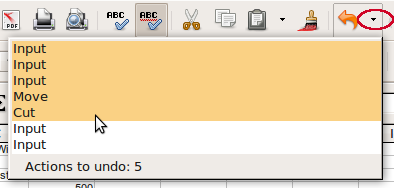Making changes to contents of cells
| Working with Spreadsheets in OpenOffice.org Calc | |
|---|---|
| Working with cells | Selection | Inserting | Deleting | Widths and heights | Entering data | Changing contents | Copy, move, delete | Shifting cells | Sorting data | Speeding data entry | Find and replace | Practice | Summary |
In the last activity, you took the first steps in editing data, getting inside the cell. Continuing on this topic, let's review the edit process and then look at a number of functions that can adjust the data contained in cells. Remember that data in a spreadsheet may be of two types: numerical and alphabetical. We will be encountering both in the activities to follow.
Edit existing content of a cell
A quick review. You perform this task to add, insert or delete text to or from the existing contents of a cell. You do this in the Input line of the Formula bar.
- Select the cell whose contents need to be revised.
- Click in the Input line to change to edit mode.
- Revise the data as needed.
- Press Enter, Tab, or an arrow key when the revision is complete.
Replace contents of a cell
Sometimes the quickest way to make a correction is to overwrite the data in the cell with the new content. Remember overwriting "Cost" with "Total Cost" a few pages back?
The operation is simple: select the desired cell and type the new data. As soon as you start typing, the old data disappears. No need to use the Input line.
Use the undo and redo commands
Again, you have already used the undo command via the undo button, ![]() . Sometimes when editing or formatting you make a mistake and want to return the worksheet to a previous state. The undo command goes back one step for each time it's implemented.
. Sometimes when editing or formatting you make a mistake and want to return the worksheet to a previous state. The undo command goes back one step for each time it's implemented.
You can implement the undo command in three ways:
In fact, the undo button contains the history of changes made in the current editing session, up to a default number, typically 100. You can repeatedly press the undo button to go back one step at a time, or click the down arrow next to the undo button on the Formatting bar, and choose an earlier step to return to in the dropdown box.
Use the redo command to reinstate a later version after using undo command. The redo command reverses the action of the undo command. This is useful if you'd like to try out adding a new item to a spreadsheet; you can compare the earlier and later version and pick whichever you like better.
To implement the redo command:
Note that the redo command contains a revision history accessible via the down arrow next to the redo button.
The best way to understand how undo and redo work is to use them while editing. In the activities that follow, take a moment here and there to try out undo and redo.
